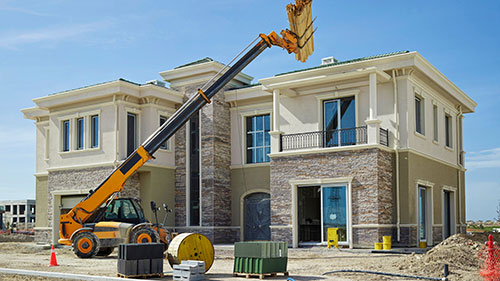 Selecting business software for a medium to enterprise-sized construction concern is extremely challenging in large part because most enterprise resource planning (ERP) suites originated in the world of repetitive manufacturing and are therefore a poor fit for a project and asset-centric business.
Selecting business software for a medium to enterprise-sized construction concern is extremely challenging in large part because most enterprise resource planning (ERP) suites originated in the world of repetitive manufacturing and are therefore a poor fit for a project and asset-centric business.
IFS started to market its enterprise suite to the engineering and construction sector over 15 years ago. Our biggest successes have been with major global construction and engineering contractors. But long before that, our software suite started life providing solutions to asset centric industries, so right from the beginning our solution was focused on project and asset lifecycle management. That later expanded into manufacturing ERP. This historic strength on the asset management side is important because more and more construction contracts involve building information modeling (BIM).
It is becoming critical that your ERP solution has the right structure to allow the BIM model data to be integrated to the project and asset lifecycle processes that an asset centric ERP solution provides. This approach will allow your organization to move to a true digital asset lifecycle model and gain the real benefits of implementing a BIM and digital strategy. But despite our strength in asset lifecycle management, we found we still had to learn a lot about the ideal ERP solution for construction contractors.
Based on some of the lessons we learned on our journey working in this sector, here is a checklist of things to add to your request for proposals (RFP) for enterprise software for your contracting business. The engineering and construction industry is unique, and in order to deliver a viable solution out of the box, an enterprise software company will need to have made substantial investments in their product to make it fit your business.
Let’s discuss specifically the core construction business processes that may be missing from many ERP suites. Enterprise software stays in place in a company for decades, so it is important to look not just at optimizing today’s business processes in a new ERP but preparing for the best practices and business requirements of tomorrow.
Contract Management and Agile Progress-Based Billing Including Support For Applications For Payment
One of the first lessons we learned when we started seriously pursuing the construction industry was that revenue enters a construction company through a very different process than a product-related company. We needed to create software tools that would support a cumulative application for payment process. This requirement cannot be satisfied by using traditional ERP sales orders as we need to support proper contract management with the capability to manage variations, contract change, retentions, flexible contract structures such as bill of quantities and flexible methods of measuring progress.
So a team at IFS went to school on all of the best solutions on the market and came up with a requirements document to drive our development project. I gave it to a very smart guy at our development center in Sri Lanka, and he got the whole module written in a few months.
But remember that application for payment or claims is not a one-size-fits-all scenario. Construction companies need to support highly variable contracts. When we ask a customer if they bill by fixed price, time and materials, lump sum, progress-based or value-based they normally say “all of those.” Every owner has unique contractual requirements, so construction ERP must be adaptable to the contract terms the owner wants.
Subcontracts and Subcontractor Management
Very few contracts are 100 percent performed by a single contractor. Extensive portions of the project scope are performed by subcontractors. In some IFS customers, as much as 90 percent of project costs are coming from subcontracts.
Many ERP systems will try to get you to use purchase order functionality to manage a subcontract, but that is entirely inadequate. Subcontracts are really just back-to back-contracts, and that has implications for how the original head contract or master contract is structured and for how subcontractors value work done, report progress and make claims or applications for payments and are ultimately paid. What are the payment terms? Is the subcontractor paid when the contractor is paid by the project owner or immediately on completion of a progress valuation? How does the software automate the entire process of letting and accepting bids from subcontractors and then automating the cascading impact of change orders and variations on each subcontract?
We also need to be able to manage risk so the ability to manage sub-contractor insurances and indemnities is an essential feature in the construction industry. The ability for the sub-contractor to enter applications/claims in a web portal is also becoming increasingly important.
Finally, the software must manage the month-end accrual process properly with these complex sub-contracts. This is key month end process so be sure to check that the system can handle it properly.
Changing Contract Scope and Impact on Cash Flow
Construction ERP must measure the revenue, cost and timeline impacts of incremental changes against a contract. Change orders or variations are common, and each one will have implications for the contractor and their subcontractors. Changes must flow through the business software so we have accurate information on the current scope and progress status. Tracking changes will also have implications for cash flow and risk management.
Changes to scope are one thing, but changes to the anticipated timing of revenue events is another. Remember that the application for payment process is the mechanism to get cash in, and the key word here is “apply.” Even the word “claim,” which is sometimes used, is not very strong as the client may modify or deny your claim. Even if you have well-founded valuations against a scope and present these to the client, they may certify a smaller amount than you are claiming. Usually this is a cumulative valuation process so any balance must be carried over and re-applied for, from one billing period to the next. Construction ERP must provide visibility into the cumulative contract valuations both for the head/client contract and subcontracts.
Some contracts may also include a holdback or retentions, which means that a certain percentage or value of each payment may be withheld until after project completion.
Project Plan/Program Should Be Integrated with the ERP Project Work Breakdown Structure
The project plan or program should define the current phasing and timeline for the project. Most engineering and construction companies do this planning process in project planning tools such as Primavera, Microsoft Project or Asta Power Projects. This plan should be integrated with the ERP solution and not just be a pretty picture of a Gantt chart that is only used by the project planners. So, the solution is either to have the ERP tool do project planning or integrate the ERP’s project work breakdown structure with a third-party project planning tool.
With the plan integrated to ERP, the solution can then drive the official plan down into the business so that all departments involved in the execution of the project are working to the same plan. This will increase the chances that the project will be delivered on time. In this scenario all sub plans are aligned. (for example procurement plan, engineering/ design plan, manufacturing plan, shipping plan, construction, installation and asset handover plan.)
Modular/Offsite Construction
If you are not performing a portion of your scope offsite in a shop environment, you may well in the future. So construction ERP should include manufacturing functionality as well so that your business can move to support an offsite strategy in the future without having to purchase and integrate another ERP solution or worse have to throw your existing ERP solution away.
By 2022, modular construction is expected to constitute 6 percent of all construction activity. In Sweden, about 84 percent of detached homes-built use pre-fabricated timber elements. In Japan, 25 percent of all new houses are modular construction, while the U.S., Australia, and the UK all hover at about 5 percent.
Third World countries meanwhile represent major markets for prefabricated housing. The United Nations Humans Settlement Program (UN-Habitat) is for instance working with the Nigerian Navy to build 20,000 modular units as affordable housing for Nigerian sailors.
Offsite and modular will be important for a few reasons, not the least being increased labor utilization. It allows you to use staff more efficiently than you could on distributed construction sites. On the whole, modular construction will let you deliver projects faster, for less money and at a higher degree of quality than you could completing the majority of work on site. Manufacturers in recent decades have increased their productivity a lot more than have construction contractors. The contractors who win in the next five to 10 years will be the ones who can quickly adopt lean principles manufacturers have been perfecting since Henry Ford.
Construction ERP will need built-in, native tools for everything from lean approaches to inventory, traceability, scheduling and machinery and asset management.
Embedded Human Capital Management Capabilities
Construction ERP must address the various cost and revenue centers of construction, including labor. This focus on people must extend beyond simple cost accounting. The software must let executives plan around forecasted demand for labor with various certifications and seniority, so they can recruit around those targets. The goal is to increase the ability to deliver along with quality. Better forecasting gives you a longer lead time, so you can build a backlog and then recruit qualified individuals. More qualified individuals have the skills to deliver against the contract at the highest level of quality, so you can meet project owner expectations. If you use subcontract labor, then your human capital management tools should also support the management of subcontract labor.
This information, properly structured, can help contractors with mandated reporting to project owners and regulators, too. But mainly, it enables us to treat human resources as a tool to help deliver projects successfully.
Support Labor-Based Self-Perform Project Delivery
If you deliver projects using your own labor, then the solution must support the ability to book time to projects. The solution will therefore need to be flexible to support different types of time recording depending on the type of labor doing the work. You will need to account for monthly professional staff such as project managers, quantity surveyors, commercial or contract managers, site managers, estimators, engineers and others. You will also need to include site-based trades such as brick layers, electricians, scaffolders and operating engineers.
Site-based people will typically be paid weekly using complex payment rules with allowances and union rules. You will need a mobile time-based solution to support this while driving payroll as part of the project costing. Flexible options to book both attendance, absence and work package time and expense recording are all requirements. During monthly management planning, you will need to book time to the project work breakdown structure in a simple way.
There may also be a need to manage resource allocation to work packages or directly to the project ahead of booking the actual time. This is more likely if your organization has a large labor force working directly on projects.
Equipment Rental/Hire and Asset Management

Contracting generally involves some capital equipment, and construction ERP should help you:
- Maximize utilization rates for your owned equipment
- Accurately rent/hire and bill equipment to external customers
- Accurately rent/hire and charge equipment to internal projects or work packages
- Support rental/hire of external equipment from third-party suppliers (proper rental/hire purchasing software features)
- Capture proper accruals and cost controls
- Intelligently blend owned equipment with rental equipment to mitigate risk while remaining responsive to spikes in demand
It used to be more common for contractors to own the overwhelming majority of the equipment used on projects. Increased use of rental equipment can reduce the amount of cash tied up in capital assets and solve problems with under-utilized equipment. But without the right ERP, contractors often rent equipment when they already have the right piece of equipment idle in the yard or pay rental fees for long periods of a project timeline when the equipment is not being used and is not required on site.
Contractors are often bad at managing their own equipment, and things get more difficult for them when they start operating their own rental divisions for complex assets like tower cranes. Tower cranes consist of multiple sections of lattice that are configured into a mast along with slewing units, jibs, working arms and cabs. All of these components are configured into an asset and rented or loaned to a contractor’s own jobs. Operating or renting this crane requires a full enterprise asset management (EAM) solution that can track utilization, cost and reliability by each component and the completed, configured asset. The EAM software must also have the project functionality to facilitate assembly, maintenance, disassembly larger maintenance projects and repair/replace decisions.
At the C-level, they need to be able to see if critical assets are making them vulnerable. While relying on rental equipment can solve availability problems, the total cost will be high in some cases if they rely on rental equipment. So, if there is a strong forecast for demand, they may consider investments in that equipment class, so they don’t needlessly hand margin to a rental company. Sometimes, the assets they own may be nearing the end of their lifecycles or just not performing adequately, and they need to either replace those assets or rent equipment to preserve capital. Whose businesses are those profit centers feeding? They want the rental division to make money. What equipment is making or losing money, and what are utilization levels? What does this mean for CAPEX and OPEX?
Construction ERP should automate creation of a project rental plan. What equipment is required, what are you consuming of your own equipment and what equipment do you need to rent, when? This should update itself as the project timeline shifts due to change orders and other factors. If your company owns its own equipment and you need a 100-ton lattice boom crane for three specific days on the schedule, that updates a demand profile for your asset. If you also rent equipment to other contractors, you update the same demand profile for the asset when external parties consume the asset. This lets you more accurately and reliably serve your rental customer while also informing your CAPEX and OPEX decisions.
This will be orders of magnitude better than common practice today. Few contractors have formal processes for estimating or scheduling equipment based on the contract. They might not reliably know where all of their equipment is at all times, and if it is sitting idle on a job site between scheduled tasks. They would also have a hard time making informed decisions about what equipment to buy, when rental equipment will be required or managing their own equipment rental division.
Project Cost and Cash Forecasting
Project financial control is perhaps the most important requirement and should ideally be an integral part of your ERP solution. Too often, the ERP accounting solution does a reasonable job of the standard financial accounting processes but does not support the more important project financial controls required to ensure that projects come in on budget and cash is managed properly.
The periodic project cost, revenue and cash forecasting processes are, in most construction companies today, still done in Excel. This is because too often the ERP solution does accounting only but was never designed to be a proper project and construction-centric financial control solution. Many companies make the mistake of assuming they will be equipped to do this if they buy the big ERP solutions.
A proper construction-centric ERP solution should support these key processes. It should support the ability to forecast a project estimate to complete (ETC) and estimate at complete (EAC) on a monthly basis. Cost and work breakdown structures and contract change/variation management should also be tightly integrated with this process.
Risk, Quality and Health and Safety and the Environment (HSE)
We have found it is important for construction ERP to support contractors in not just highlighting and putting value to risk but linking that to corporate performance. This means that risk can more easily be balanced against revenue, potential margin or other upside metrics.
The software should also be able to track risk from nonconformance to contract or quality requirements both in a contractor’s operation as well as among its subcontractors. Contractors need to manage subcontracting risks in terms of both ability to perform and subcontractor insurance. By tracking the relevant insurance coverages alone and ensuring coverage is current and aligns with contract requirements, software can dramatically reduce risk exposure along with administrative overhead.
Software must also track safety incidents and nonconformances that may lead to safety incidents. This includes accidents on a construction site or incidents related to building or project failure after construction.
Contractors also must deliver structures and projects that meet environmental criteria, from building performance to small business set asides. Contractors also need to measure how they improve their risk profile by reducing their environmental impact and adopting other sustainable business practices. Corporate social responsibility is often dealt with specifically in requests for proposals. Construction ERP should give a contractor the ability to look more deeply at their impact on people and the environment well beyond what is required for compliance reporting. They should be able to reconcile their nonfinancial impacts against industry benchmarks or a contract just like they reconcile their other accounts to the general ledger. These CSR measures might include:
- Sustainable labor practices like prevailing wage
- Woman- or minority-owned status
- Average building performance
- Re-use of materials or other recycling
- Use of alternative fuels in vehicles
Embedded Document Management Tools
While construction may be becoming more data driven as owners, contractors and subs share structured data about an asset being created through BIM, there are still plenty of documents required to manage the project lifecycle processes. That is why construction ERP should include embedded document management.
All engineering and construction projects have thousands of documents to manage through the life of a project and beyond, through operations, maintenance and decommissioning.
While these documents contain material critical for every function of the business, they are rarely well-managed. These include things like images taken during inspections, materials testing reports, training manuals, employee certifications, insurance policies, email correspondence, and executed contracts and agreements. You will usually find them:
- On individuals’ personal computers
- In a variety of document management systems and Windows folders
- In Sharepoint
- In hard copy, paper documents
- In a number of digital document formats that not everyone in the business has the right software to access
Even if you know where to look and can find a document, it is difficult to know if you are looking at the correct revision.
To compound this problem, without ERP with embedded document management, these documents are not referenced against the relevant business object in business software. Should that document be associated with a project, purchase order, invoice, part, design object, employee, subcontract, asset ID, work package or incident? Should it be attached to multiple screens, records or business objects at once? The answer to both of these is an emphatic yes.
A construction ERP solution should have integrated document management that allows documents to be associated and accessed directly from the business object, increasing usability and ease of access. Embedding documents in a secure ERP solution means that the same user role-based security and access permissions apply to the documents they are entitled to see, automating compliance with regulations like Sarbanes-Oxley, the Global Data Privacy Regulation (GDPR) and information about an employee’s health status and internal investigations. Strategic plans and information on major future initiatives and financial results may require protection to avoid leaking data to competitors or creating liabilities for public companies.
Some documents will also benefit from embedded electronic approval workflows, transmittals and revision control to ensure their integrity and the integrity of the information they contain are protected.
Service and Facilities Management

Increasingly, the client and asset owner would like someone to take ownership of the asset through its entire life. Why should they contract with one organization to build the asset and then one or more to operate and maintain the asset once it is commissioned? Every asset has a purpose to deliver—an outcome. A hospital makes patients better—or a school produces education deliverables.
The trend is moving towards a contracting for outcomes model instead of the physical asset. What this means is that if you are an engineering or construction company today, you should be in a position to provide service or facilities management as well and be prepared to contract for outcomes if the need arises in the future. It makes sense to select an ERP solution to support the whole asset lifecycle properly and not just the construction stage of its life.
In short it should have strong EAM and service management components with the ability to take advantage of emerging technologies such as IoT and BIM and digital twins. The contracting for outcomes model is also considered green because a contractor’s revenue and margin is pegged against the output of the assets they deliver rather than on square footage or linear feet or material and manhours used in construction. This can result in reduced waste and increased recycling by incenting designers and engineers to look at the total lifecycle cost of the asset including the impact of construction and operation on the environment, which would normally be externalized onto society. Contractors need the ability to support these contracts and then measure resulting reduction in environmental impacts.
Conclusion
Selecting enterprise software is difficult in any industry, but it is doubly so in construction because standard ERP is a poor fit for the industry. Yet midsize to large contractors need the predictable, auditable processes that ERP delivers. Contractors will also need to innovate and evolve their service offerings going forward, and the ERP they select and implement must support them as the methods by which they deliver value to project owners changes.


